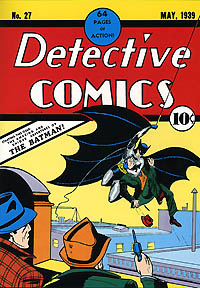|
|
|
|
|
|
|
|
|
Pre-History |
|
|
Creator Bob Kane |
Before one begins to talk about the history of the 1966 Batman television series, they have to start back in 1939 with a young artist named Bob Kane. After Kane had worked on a few strips for D.C., editor Whitney Ellsworth approached him about creating a costumed hero to help the company follow the success they had been having with Superman. Kane shared his ideas with writer Bill Finger. Bob created a character with what looked like batwings and a regular “domino” mask. Bill suggested a cowl with ears like a bat and a cape, and Batman took his recognizable form. Though Bob came up with the initial character, Bill fleshed him out and gave him a background and an air of mystery. They made him a millionaire playboy by day, Bruce Wayne, and a grim vigilante / detective by night, Batman (or as he was first |
| called The Bat-Man.) Following such leads as other popular heroes of the day like Zorro, the Shadow and the Green Hornet, Batman took on the seedy world of crime in Gotham City. | |
|
|
 Click for Origin |
|
“superstitious and cowardly lot,” Bruce figured he should become something that would strike fear into their hearts. He found his answer when a bat suddenly flew through the window. He would become a bat… Batman was born! Batman evolved quickly for the next year and by issue 38 he took on a youthful partner and sidekick, Robin the Boy Wonder. Named and costumed after Robin Hood originally, though the bird association would prevail over the years, Robin was a young acrobat, Dick Grayson. His parents were murdered during a trapeze act by a saboteur to pressure the circus to pay “insurance” money. Bruce Wayne, who witnessed the tragedy and sensed the boy’s loss as the same he experienced with his parents, took Dick Grayson under his wing as Batman. He then revealed his true identity as Bruce Wayne and created the classic team of Batman and Robin. The rest, as they say, is history…. BUT WAIT!!…THE BEST IS YET TO COME!!!
|
|